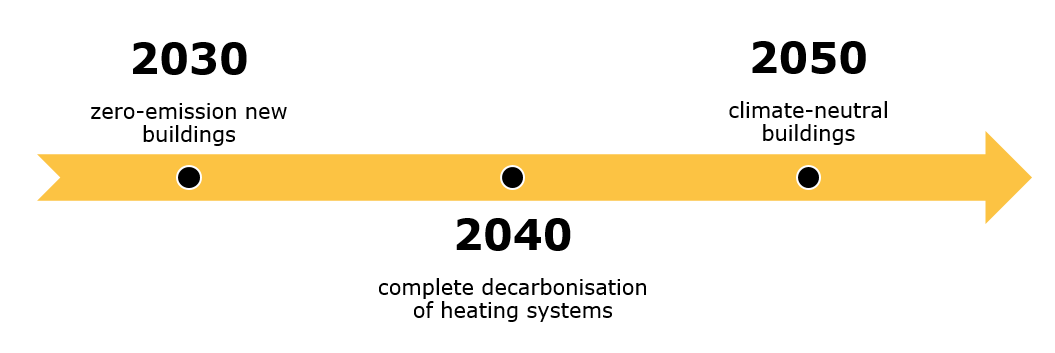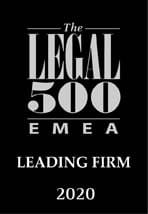The European Commission’s “Fit for 55” programme includes the revision of Directive 2010/31/EU on the energy performance of buildings, where the focus is on vision that calls for a zero-emission building sector by 2050. This article describes the decarbonisation goals that have been set for the period up to 2030 and then to 2050 as a result of the revision of the Directive.
Key parts of the package
The European Union is committed to developing a sustainable, competitive, secure and decarbonised energy system. The steps that are designed achieve these objectives include the reduction of greenhouse gas emissions, increasing the use of renewable energy, energy savings in line with Community-wide goals, and improving energy security, competitiveness and sustainability.
Reasons for the revision: A large part of the energy consumed in the European Union (40%) is used in buildings, about 1/3 of greenhouse gas emissions originate from buildings, and 80% of the energy consumed in our homes is used to provide heating, cooling and hot water. Additionally, 85% of the buildings in the European Union were built before 2000 and 75% of them are energy inefficient, and therefore energy savings and having decarbonised, zero-emission buildings will be key to achieving Fit for 55 objectives. Consequently, the EU started working some time ago on various pieces of legislation that focus on increasing the energy efficiency of buildings. With this in mind, the revision of Directive 2010/31/EU on the energy performance of buildings and Directive 2023/1791/EU on energy efficiency will have heightened importance.
Purpose of the revision: The objective of the revised Directive is to increase the rate of renovation in buildings with the poorest energy performance across the European Union, create a stable environment for investment decisions, enable consumers and entrepreneurs to make well-informed decisions regarding energy savings solutions, and place greater emphasis on sustainability goals.
Emission reduction target values
Member States can seek to meet emission reduction target values on the basis of Global Warming Potential (GWP)[1], including greenhouse gas emissions associated with the production, installation and disposal of construction materials.

Chart 1: objectives in the revised Directive
The revised Directive also includes certain milestones that will have to be met. As the chart above shows, Member States must realise an almost 60% emission reduction in the construction industry compared to 2015 levels by 2030, and achieve climate neutrality by 2050.
The purpose of emission reduction plans is to ensure a significant reduction in the greenhouse gas emissions and the energy consumption of buildings throughout the European Union. To this end, new buildings will have to be zero-emission by 2030. This requirement will apply to new buildings that are owned or operated by public authorities from 2028.
Member States will have to implement measures aimed at the reduction of the consumption of primary energy in residential buildings, which is expected to result in a reduction of at least 16% in the average consumption of natural primary resources by 2030 and approximately 20% by 2035.
The purpose of certain minimum standards that will be introduced gradually with regard to buildings with the poorest energy efficiency (typically commercial and industrial buildings) is to ensure that 16% of the buildings in this class are renovated by 2030 and 26% by 2033.
Member States are also required to install solar panels by 2030 on existing public and non-residential buildings that meet the relevant technical and functional requirements. Additionally, equipment capable of utilising solar energy will also have to be installed on new buildings.
As progress towards decarbonisation is made, another important step in the modernisation of buildings and building systems, and the integration of energy systems will be the gradual phasing out of fossil fuel boilers. Therefore, one of the objectives is that no fossil-fuel burning boilers should be in operation by 2040. In the first stage toward that goal, restrictions should be placed on the use of fossil fuels: starting from 2025, Member States may not grant financial assistance for the installation of stand-alone fossil fuel boilers, with the exception of hybrid systems with solar thermal technologies or heat pumps.
The ambitious ultimate goal of the revision of the Directive is that buildings should be completely climate-neutral by 2050.
Exceptions
The above prohibitions and restrictions will not apply to agricultural buildings and protected monuments, or to buildings that are officially listed as protected buildings due to their architectural or historical significance. The new rules will also not apply to buildings thar are used temporarily, or to churches and other places of worship.
Summary
The revised Directive will allow each Member State to develop its own long-term renovation strategy that best fits it needs and circumstances as determined by climatic and geographical factors, and the general state of its existing buildings. The revised Directive, in conjunction with the rest of the package – such as the revised Energy Efficiency Directive, the revised Renewable Energy Directive and the Alternative Fuels Infrastructure Regulation – can guide the construction industry along a path to sustainability and allow for more precisely targeted financing in construction projects.
Authors: András Fenyőházi and Anna Nánási


[1] GWP measures the rate at which a particular greenhouse gas of a given mass heats up the atmosphere compared to carbon-dioxide of the same mass.


